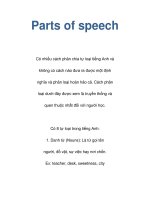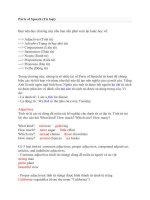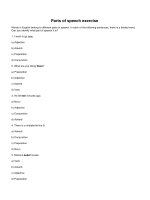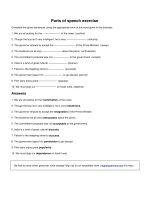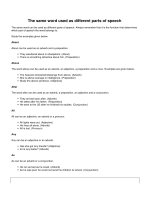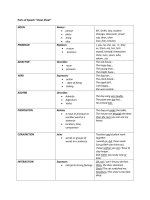UNIT 9 parts of speech
Bạn đang xem bản rút gọn của tài liệu. Xem và tải ngay bản đầy đủ của tài liệu tại đây (119.83 KB, 4 trang )
UNIT 9: PARTS OF SPEECH
(Các phần của lời nói/Từ loại)
Cách nhận biết từ loại dựa vào vị trí khi làm bài tập chọn từ loại.
I. Danh từ (nouns): là từ dùng để gọi tên người, sự vật, sự việc (Maria, family,
team, information, education,...)
1. Chủ ngữ của câu, tân ngữ, bổ ngữ.
Ex: Maths is the subject I like best. (Chủ ngữ)
I like Maths best. (Tân ngữ của động từ)
Sucorp moved to its new office last month. (Tân ngữ của giới từ)
You are a liar. (Bổ ngữ của chủ ngữ)
They elected him chairman. (Bổ ngữ của tân ngữ)
2. Sau tính từ/tính từ sở hữu/sở hữu cách/một danh từ khác: good, beautiful; my,
your, our, their, his, her, its;the manager’s..., the barber’s...;noun of noun; noun + noun.
Ex: She is a good teacher.
His father works in hospital.
Latzer’s edition is very useful.
Employees have to meet the production schedule.
4. Sau “enough”.
Ex: He didn’t have enough money to buy that car.
5. Sau các mạo từ a, an, the hoặc các tính từ chỉ định this, that, these, those, hoặc các
từ chỉ số lượng each, every, both, no, some, any, few, a few, little, a little,.....
Lưu ý cấu trúc: a/an/the + adj + noun
Ex: This book is an interesting book.
Some cars on the list are not available in Korea.
? Some__________problems have been solved by Mr. Smith. (difficulties – difficult)
6. Sau giới từ: in, on, of, with, under, about, at......
Ex: Thanh is good at literature.
II. Tính từ (adjectives): bổ nghĩa cho danh từ hoặc đại từ.
1. Trước danh từ: Adj + N
Ex: My Tam is a famous singer.
2. Sau động từ liên kết: tobe/seem/appear/feel/taste/look/keep/get + adj
Ex: She is beautiful.
I feel sad.
This shirt looks good on you.
Chú ý: cấu trúc keep/make/find + O + adj
Ex: He makes me happy
I found the film boring.
3. Sau “ too”: S + tobe/seem/look....+ too +adj...
Ex: He is too short to play basketball.
4. Trước “enough”: S + tobe + adj + enough...
Ex: She is tall enough to play volleyball.
5. Trong cấu trúc “so...that”: tobe/seem/look/feel.....+ so + adj + that
Ex: The weather was so bad that we decided to stay at home
6. Tính từ còn được dùng dưới các dạng so sánh (lưu ý tính từ dài hay đứng sau more,
the most, less, as....as)
Ex: Meat is more expensive than fish.
Huyen is the most intelligent student in my class
7. Tính từ trong câu cảm thán: How +adj + S + V = What + (a/an) + adj + N
How complex you are!
What a beautiful dress!
8. Stay/remain/keep (giữ cho/duy trì) + Adj
Keep silent! The baby is sleeping.
My mother remains strict to us although we are adults.
III. Động từ (verbs): chỉ hành động hoặc trạng thái của người hoặc vật.
Vị trí của động từ trong câu rất dễ nhận biết vì nó thường đứng sau chủ ngữ (Nhớ cẩn
thận với câu có nhiều mệnh đề).
Ex: My family has five people.
I believe her because she always tells the truth.
IV. Trạng từ (adverbs): là từ dùng để nhấn mạnh. Trạng từ là từ dùng để bổ
nghĩa cho động từ, tính từ, một trạng từ khác hay cho cả câu. Thiếu động từ câu vẫn
đủ nghĩa và đúng ngữ pháp.
1. Trước động từ thường (nhất là các trạng từ chỉ tần suất: often, always, usually,
seldom....)
Ex: They often get up at 6am.
2. Giữa trợ động từ và động từ thường.
Ex: I have recently finished my homework.
3. Đứng cuối câu, bổ nghĩa cho động từ
Ex: The doctor told me to breathe slowly.
4. Trước tính từ, bổ nghĩa cho tính từ: tobe/feel/look... + adv + adj
Ex: She is very nice.
I feel extremely interested in this film.
5. Đứng trước trạng từ bổ nghĩa cho trạng từ đó.
Ex: She drives very carefully.
6. Sau “too”: V(thường) + too + adv
Ex: The teacher speaks too quickly.
7. Trước “enough” : V(thường) + adv + enough
Ex: The teacher speaks slowly enough for us to understand.
8. Trong cấu trúc so....that: V(thường) + so + adv + that
Ex: Jack drove so fast that he caused an accident.
9. Trạng từ cũng thường đứng một mình ở đầu câu, bổ nghĩa cả câu.
Ex: Suddenly, he heard a strange voice.
Cách nhận biết từ loại dựa vào cấu tạo từ khi làm bài tập.
I. Danh từ (nouns)
danh từ thường kết thúc bằng: -tion/-ation, -ment, -er, -or, -ant, -ing, -age, -ship, -ism,
-ity, -ness
Ex: distribution, information – development - teacher - actor - accountant - teaching,
studying - teenage - friendship, relationship, shoolarship - socialism - ability - sadness,
happiness...
II. Tính từ (adjective)
Tính từ thường kết thúc bằng: -ful, -less, -ly, -al, -ble, -ive, -ous, -ish, -y, -like, -ic, -ed,
-ing
Ex: helful, beautiful, useful - homeless, childless - friendly, yearly, daily - national,
international - acceptable, impossible - active, passive, attractive - famous, serious,
dangerous - childish, selfish, foolish - rainy, cloudy, snowy, sandy, foggy, healthy,
sympathy – childlike - specific, scientific- interested, bored, tired - interesting, boring
III. Trạng từ (adverbs)
Trạng từ thường được thành lập bằng cách thêm đuôi “ly” vào tính từ
Ex: beautifully, usefully, carefully, bly, badly
Lưu ý: Một số trạng từ đặc biệt cần ghi nhớ
Adj
Adv
Adj
Adv
good
well
Far
far
late
late/lately
Near
Near
ill
ill
long
long
fast
fast
hard
hard
early
early
